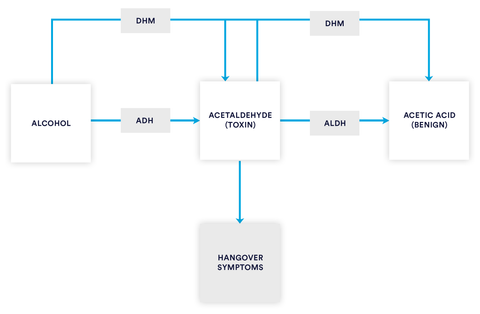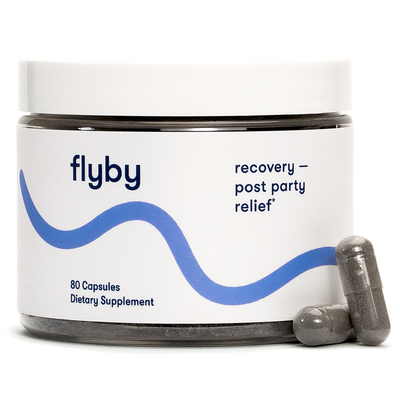Dihydromyricetin: Uses, Side Effects, Interactions, Dosage, and Science
January 01, 2019

What is Dihydromyricetin (DHM)?
Dihydromyricetin (DHM) is a hepatoprotective flavonoid extracted from Hovenia Dulcis, a Japanese raisin tree that's famous in the traditional medicine world. It's been used since the year 659 throughout Japan, China, and Korea as a hangover cure.
But Dihydromyricetin didn't come into the spotlight until 2012, when an associate professor from the UCLA School of Medicine–called Jing Liang performed a study that involved mice getting drunk while using DHM–that it became clear that there was real science behind the ingredient.
The Science of Dihydromyricetin
Liang and her research team first tested whether dihydromyricetin blocks the effect alcohol has on GABA and Glutamate neurotransmitters in the brain. Alcohol binds to GABA receptors and activates them, leading to relaxation, slurred speech and impaired motor function (the feeling of being intoxicated). So they paid close attention to any changes in cognitive skills, clumsiness, and loss of coordination through a series of tests.
| Researchers injected rats with a dose of alcohol (EtOH) equivalent to a human drinking 20 beers in two hours and the results were quite astounding. |  |
1) Dihydromyricetin prevents intoxication
They first examined the effects of DHM on LORR (Loss of righting reflex) or the time it took rats to flip while being placed in a V-shape cradle. When administered alcohol with DHM or a placebo, the DHM dosed rats had a significantly lower LORR.
However, when administered flumazenil a drug that blocks the GABA receptors, all the benefits of DHM were instantly lost. This suggested that DHM works in the same way, by blocking alcohol from activating those receptors and therefore preventing the rats from getting intoxicated, despite the large amounts of alcohol in their blood.This supports other data that GABA receptors are key in the actions of alcohol and that targeting this interaction is a viable approach to reducing alcohol intake,” says David Nutt of Imperial College London, former head of the British government’s advisory committee on drugs.
2) Dihydromyricetin accelerates the breakdown of alcohol
The researchers tested the rat's blood at intervals after giving them the equivalent of 15-20 drinks. They found that when given DHM with alcohol, the rats regained their composure within just 5 minutes, versus 70 minutes.
But what was happening beneath the surface was even more fascinating. Dihydromyricetin actually increased the activity of liver enzymes ADH and ALDH, which metabolize alcohol and its toxic byproducts faster. We've broken down the basic process involved in the breakdown of alcohol here:
|
 |
When you drink more alcohol than your liver can break down, these alcohol-induced toxins build up and put a significant amount of stress on your body. The longer these toxins linger in your body — the worse you feel the next day. Having an ADH or ALDH enzyme deficiency can worsen the severity of this toxin build up. But luckily, DHM helps speed up this entire process so you can wake up feeling clearer and refreshed.
3) Dihydromyricetin reduces alcohol addiction & withdrawal symptoms
Researchers gave the rats a choice between a sweetened solution of alcohol or sweetened water. Normally, rats will develop an addiction to alcohol within several months, but studies found that the group of rats given DHM drank significantly less than the group that didn't. Moreover, the rats that were already addicted to alcohol also significantly reduced their alcohol intake when given DHM.
Lastly, the rats were put into a maze, and when given alcohol with placebo, they behaved erratically, stumbling around and cowering away from the corners of the maze. These were clear signs of anxiety associated with alcohol withdrawal. But those treated with DHM behaved normally and were as inquisitive as rats given no alcohol at all, exploring different corridors of the maze.


How Do You Take Dihydromyricetin?
Suggested Dosage: 300 - 4000mg
We've optimized the following dosages based on clinical studies, data we've collected from hundreds of thousands of customers and conversions from rat models. To reduce effects of intoxication, we recommend you take DHM before drinking whereas if you want to prevent hangovers, it's recommended to take it during or right after drinking.
Clinically, the Hovenia dosage range used for hangover is 100–650 mg/kg (Li, 1590). Total flavonoids purified from Hovenia are 4.53% of the extract, of which DHM accounts for ∼40%, suggesting a 1–15 mg/kg dose for behavioral assays.
To reduce intoxication: 2000 - 4000 mg
To prevent hangovers: 300 mg per "standard" drink
Does Dihydromyricetin Have Any Side Effects?
Dihydromyricetin has been used in Asia for thousands of years as a hangover cure and anti-intoxication medicine and is considered safe for humans even in massive doses.
In a DHM toxicity study, researchers failed to find any side-effects while giving mice massive doses of up to 22g/kg body weight.
Acute toxicity tests showed that a single dose of oral SHE up to 22 g/kg did not result in any death or toxic side effects in mice during 14 days' observation.
Conversions from rat to human pharmacology can be estimated using the HED ratio of 16%, giving DHM a safe upper limit dosage of 15.68g for a 70kg person.
Drink Smarter and Live Better with DHM
Flyby was carefully formulated to support your body's normal metabolism after drinking so you wake up feeling refreshed. It helps hydrate you rapidly, support healthy liver function, and replenish lost vitamins, minerals and amino acids—which is just a fancy way of saying you will feel better after a night out.
SOURCES
- Hase, K. et al. “Hepatoprotective Effect of Hovenia dulcis THUNB. on Experimental Liver Injuries Induced by Carbon Tetrachloride or D-Galactosamine : Lipopolysaccharide” Biological and Pharmaceutical Bulletin (1997).
- Hyun, T.K., et al. “Hovenia dulcis — An Asian Traditional Herb.” Planta Medica (2010); 76: 943–949.
- Kim, M.H. et al. ”Hepatic Detoxification activity and reduction of Serum Alcohol concentration of Hovenia dulcis from Korea and China” Korean Journal of Medicinal Crop Science (2000); Vol 8, Issue 3: 225-233.
- Shen, Y. ”Dihydromyricetin As A Novel Anti-Alcohol Intoxication Medication” Journal of Neuroscience (2012); 32(1): 390–401.
- Wang, M. et al. “Preliminary characterization, antioxidant activity in vitro and hepatoprotective effect on acute alcohol-induced liver injury in mice of polysaccharides from the peduncles of Hovenia dulcis: Food and Chemical Toxicology (2012); Vol 50, Issue 9: 2964-2970.